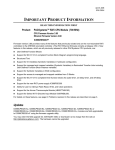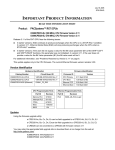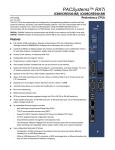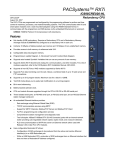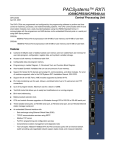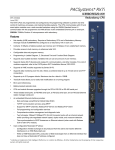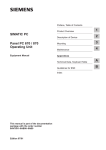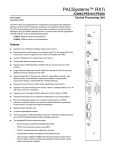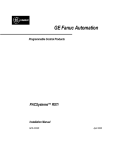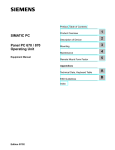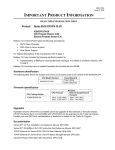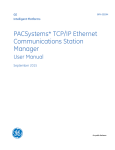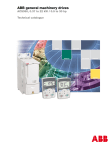Download PACSystems RX7i CPU, IC698CRE020
Transcript
October 5, 2005
GFK-2320F
IMPORTANT PRODUCT INFORMATION
READ THIS INFORMATION FIRST
Product:
PACSystems™ RX7i CPU Module (700 MHz)
CPU Firmware Version 2.04
Ethernet Firmware Version 3.00
IC698CRE020-DD and later
This is release 3.00 of the RX7i Ethernet Daughterboard firmware. (The RX7i CPU firmware remains at
release 2.04.) The two new Ethernet features in this release are SRTP Client Channels and Modbus/TCP
Server, and are further described on page 7. Problems resolved in this release are listed on page 6.
Version Identification
Hardware Identification
The following table shows the revision level of the circuit boards used in this release of the RX7i CPUs.
Catalog Number
Circuit Board ID
IC698CRE020 (CPU)
VMIVME-007633-002 Rev. F1
IC698CRE020 (Ethernet)
EX8A1_F2_R05
Firmware Identification
Firmware ID
CPU Primary
2.04 Build 44A1
CPU Boot
1.00 Build 21B2
Ethernet TCP
3.00 Build 15A1
Ethernet Boot
1.50 Build 46A1
CPU Programmable Parts
Part ID
Version
Ethernet Programmable Parts
Revision
Part ID
Memory PLC
5/19/03
PLD
Interrupt PLD
5/11/02
FPGA
6/18/03
MCU
11/03/03
BIOS
1.04
Revision
6006_U6_PLD_A.jed
Updates
Any IC698CPE020-Ax, IC698CPE020-Bx, IC698CPE020-Cx, or IC698CRE020-Ax modules are field
upgradeable to IC698CRE020-xD using the firmware upgrade utility.
You may order the field upgrade kit, 44A752281-G06, or download it at no charge from the web at
http://globalcare.gefanuc.com/. The hardware cannot be upgraded.
Important Product Information
2
GFK-2320F
Product Documentation
PACSystems RX7i CPU Reference Manual, GFK-2222
PACSystems RX7i Installation Manual, GFK-2223
PACSystems Hot Standby CPU Redundancy User’s Guide, GFK-2308
PACSystems RX7i Memory Xchange Modules User’s Manual, GFK-2300
TCP/IP Ethernet Communications for PACSystems User’s Manual, GFK-2224
PACSystems TCP/IP Station Manager Manual, GFK-2225
PACSystems RX7i C Toolkit User’s Guide, GFK-2259
Proficy Machine Edition Logic Developer – PLC Programming Software Getting Started, GFK-1918
Important Product Information, PACSystems RX7i CPUs, GFK-2320F (this document)
CPU Functional Compatibility
For Ethernet functional compatibility, see page 6.
Subject
Description
Programmer Version
Requirements
Proficy™ Machine Edition Logic Developer PLC 4.5 or later must be used to program
the CRE020. (For Modbus/TCP operation, Proficy™ Machine Edition Logic Developer
PLC 5.0 Service Pack 3 or later must be used to program the PLC CPU.)
C Toolkit Compatibility
The C Toolkit for PACSystems is distributed with Machine Edition Logic Developer 4.0
or greater. Toolkit build 47A1 or later is required for use with the Release 2.00 features.
Please note: The Series 90-70 Toolkit (IC641SWP709/719) is not compatible with
PACSystems RX7i.
Series 90-70 Expansion
Rack Compatibility
The PACSystems RX7i supports Series 90-70 expansion racks.
PACSystems RX7i CPUs and the RX7i Ethernet Module do not operate in a Series
90-70 rack.
Series 90-70 Main Rack
Compatibility
Series 90-70 Main Racks cannot be used in a PACSystems RX7i system.
PACSystems RX7i CPUs and the RX7i Ethernet Module do not operate in a Series
90-70 Rack.
Single Width I/O Module
Compatibility
The following additional single width I/O modules are supported by the PACSystems
RX7i :
Analog Input, 64 Channel, 16 bit resolution, Voltage (IC697VAL264)
Analog Input, 12 bit, 32 Channel single-ended or 16 Channel differential
(IC697VAL132)
Analog Output, 32 Channel, 12 bit (IC697VAL301)
Digital Input, 64 Point (IC697VDD100)
Relay Output, 64 Point (IC697VDR151)
Digital Output, 64 Point (IC697VDQ120)
Eight Channel RTD/Strain Bridge (IC697VRD008)
Note: These modules are fully integrated when installed in the Main Rack. When
installed in an expansion rack the module must be configured as a generic VME
module.
Important Product Information
3
GFK-2320F
Subject
Description
Insulating Strips for High
Voltage Modules
An insulator strip is required on a high voltage module that is installed to the immediate
right of a module with a metal faceplate. Insulating strips should be installed on the
following modules that have versions earlier than:
IC697MDL240D
IC697MDL241D
IC697MDL250G
IC697MDL251E
IC697MDL640E
IC697MDL340G
IC697MDL341E
IC697MDL350F
Note: Current versions of these modules are shipped with the insulators installed. The
strip is visible on the back of the printed wiring assembly.
The RX7i rack is shipped with an Insulator Kit that includes enough parts to update
three Series 90-70 I/O modules, a BEM713 (Bus Transmitter) module, and a BEM731
(Genius Bus Controller) module, one GBC and one BTM.
CRE020 does not support
configuration of serial ports
via CommReq
Release 2.04 firmware for the CRE020 does not support run-time configuration of serial
ports via CommReq. Serial ports can be configured using the programmer.
Important Product Information
4
GFK-2320F
Series 90-70 Modules Compatibility with Rx7i
The following tables describe the requirements that each Series 90-70 module must meet in order to be
installed in the RX7i system.
Series 90-70 modules that have Field Upgradeable Firmware:
Hardware version
required when
installed in the main
rack
Module
Hardware version
required when
installed in an
expansion rack
Firmware
version
required
Firmware
Upgrade Kit
Important
Product
Information
90-70 GBC
IC697BEM731
SBS3*, and B or higher
B or higher
5.8 or higher
44A751619-G01
GFK-2275
90-70 PCM
IC697PCM711
SBS3*, and PCMA1
R05 or higher
PCMA1 R05 or
higher
4.05 or higher
44A286371-G15
GFK-1081
90-70 CMM
IC697CMM711
SBS3*, and PCMA1
R05 or higher
PCMA1 R05 or
higher
4.20 or higher
44A731238-G07
GFK-0754
90-70 DLAN
IC697BEM763
SBS3*, and G01R03 or
higher
Not allowed
3.00 or higher
None
GFK-1048
90-70 High Speed Counter
IC697HSC700
SBS3*, and A or higher
A or higher
1.21 or higher
44A737511-G03
GFK-1169
90-70 Analog Input
IC697ALG230
SBS3*, and A or higher
A or higher
1.6 or higher
44A731228-G03
GFK-1377
90-70 Analog Output
IC697ALG320
SBS3*, and E or higher
C or higher
1.4 or higher
None
None
*SBS3. All modules installed in the RX7i main rack that use the SBS VME interface chip are required to
have version 3 of the chip. To determine whether your module meets this requirement, look at the large
square ASIC located near the top right corner of the circuit board. The chip must have the following
markings. The most critical items are the last two lines: “SBS3” and “454-3”. (GE Fanuc started shipping
modules with SBS3’s in 1998.)
SBS
F
R
O
N
T
P
L
A
S
T
I
C
C
O
V
E
R
V
M
E
P
L
U
G
CIRCUIT
BOARD
XXXXXXX
GE FANUC
SBS3
454-3
Important Product Information
5
GFK-2320F
Series 90-70 Modules that do not have Field Upgradeable Firmware:
Module
Hardware version
required
Notes
Standard-width 90-70 BTM
IC697BEM713
H or higher
Single-slot-width 90-70 BTM
IC687BEM713
B or higher.
Version A with assembly rev "R08" or
higher is also allowed.
90-70 BRM
IC697BEM711
M or higher
90-70 Analog Expander Current
IC697ALG440
B or higher
90-70 Analog Expander Voltage
IC697ALG441
B or higher
IC697MDL240
A or higher
D and higher have plastic insulator
IC697MDL241
A or higher
D and higher have plastic insulator
IC697MDL250
E or higher
G and higher have plastic insulator
IC697MDL251
A or higher
E and higher have plastic insulator
IC697MDL252
A or higher
E and higher have plastic insulator
IC697MDL253
A or higher
E and higher have plastic insulator
IC697MDL254
A or higher
E and higher have plastic insulator
IC697MDL340
E or higher
G and higher have plastic insulator
IC697MDL341
B or higher
E and higher have plastic insulator
IC697MDL350
B or higher
F and higher have plastic insulator
IC697MDL640
A or higher
E and higher have plastic insulator
IC697MDL651
E or higher
IC697MDL652
C or higher
IC697MDL653
B or higher
IC697MDL654
C or higher
IC697MDL671
A or higher
IC697MDL740
D or higher
IC697MDL750
G or higher
IC697MDL752
E or higher
IC697MDL753
A or higher
IC697MDL940
B or higher
Important Product Information
6
GFK-2320F
Ethernet Functional Compatibility
Subject
Description
SRTP and EGD Performance
Differs from Series 90-70
SRTP and EGD performance in the RX7i differs slightly from the Series 90-70. Each
RX7i Ethernet Interface supports a greater number of SRTP connections and EGD
exchanges.
Please also note that the RX7i currently has several SRTP and EGD operational
restrictions when compared to the Series 90-70. When migrating Series 90-70
Ethernet applications to the RX7i, please carefully read the "Ethernet Operational
Notes” section on page 21.
Series 90-70 LAN Interface
Modules (IC697CMM741 and
IC697CMM742) not supported
by RX7i
Please note that the Series 90-70 LAN Interface Modules (IC697CMM741 and
IC697CMM742) are not supported by the RX7i and should not be placed in an RX7i
rack. The RX7i CPU contains an embedded Ethernet Interface. If additional Ethernet
Interfaces are required, the RX7i Ethernet Module (IC698ETM001) should be used.
Programmer Version
Requirements
Proficy™ Machine Edition Logic Developer PLC 5.0 Service Pack 3 or later must be
used to program the PLC CPU for Modbus/TCP operation.
CIMPLICITY® Plant Edition
Version Requirements
CIMPLICITY® Plant Edition 6.1 Service Pack 1a with Update 040204_s90tcp_6101
or Service Pack 2 or later must be used for Ethernet communications with
PACSystems™.
CPU Problems Resolved by this Version (CPU 2.04)
Subject
Description
TOD resets to default on power cycle
(when current month is October,
November, or December)
In previous releases of PACSystems CPU the Time Of Day clock (TOD)
would reset to the default TOD setting when the current month is >9
(October, November, or December) and the power is cycled.
HCT “Mem List” feature will not work
with PACSystems CPUs (with older
versions of HCT)
In previous releases of PACSystems CPU, the HCT “Mem List” feature
does not work when using older versions of HCT.
Ethernet Problems Resolved by this Version (Ethernet Release 3.00)
Subject
Description
IO Fault Table Web Page Display
Problem
The I/O Fault Table web page now displays correct values for various
parameters such as I/O Bus, and Bus Point.
IO Fault Table Web Page Restriction
The I/O Fault Table web page now supports the field of ‘fault description’.
%L on Reference Table Web Page
%L data is now displayed on reference table web page.
Javascript Error
The following Javascript error is no longer seen when accessing the I/O
and PLC Fault Table web pages using Internet Explorer: “
‘self.document.reform.log_textbox’ is null or not an object”
SNTP Error Logged When Not
Configured
The Ethernet Interface no longer logs an SNTP event in the Ethernet
exception log (Event = 29H, Entry 2 = 01H) even though Ethernet time
synchronization is configured as None instead of SNTP.
Station Manager “EGDCMD st” May
Report Incorrect Data
The EGD sample due time and EGD exchange state as reported by the
“EGDCMD st” command are now accurate.
Avoid Too-rapid ARP Cache Flushing
The Advanced User Parameter “fflush” can now be set lower than 5
seconds (down to 1 second).
Older Network Devices And Nuisance
Faults
The Ethernet interface no longer gives nuisance faults when connected to
certain network devices, specifically those hubs that do not complete speed
negotiation in 500 ms or less.
Important Product Information
7
GFK-2320F
Subject
Description
“Internal Error” Exception when
Duplicate EGD Producer IDS
An exception (Entry = 28, Entry 2= 24) will no longer appear in the
exception log if there is another EGD producer on the network using the
same Producer ID as the Ethernet interface.
EGD Tally Inconsistency
The EGD consumption transfer tally “DataRx” no longer increments if the
incoming EGD message is discarded due to signature mismatch.
Blink Code “2-8” on Ethernet Interface
After Multiple Rapid Power Cycles
The Ethernet Interface no longer displays a blink code of “2-8” after rapid
multiple power cycles. Resetting the Ethernet Interface returned it to
normal operation.
Don’t “Loopback” EGD
The loopback IP address 127.0.0.1 may now be used to produce and
consume EGD.
Incorrect COMMREQ Status Word for
Invalid Read Exchange EGD command
When an EGD Read Exchange command references out-of-range local
PLC reference memory, the Ethernet interface now returns COMMREQ
status word 9085H and does not write any data to local PLC reference
memory, as would be expected.
Incorrect Value in SRTP Error PDU
Message
When the SRTP Server detects an internal SRTP processing the SRTP
Destinations response, it now inserts a correct error code value into the
resulting SRTP Error PDU message (i.e. the internal SRTP error value is
now less than 40 (= 28H)).
Network Offline Fault at Powerup With
Non-default AUP Settings
The Ethernet Interface no longer logs a network offline exception (Event =
20, Entry 2 = 1) when powered up with non-default settings for “lduplexXX”
or “lspeedXX” AUP parameters.
Station Manager “EGDCMD st” May
Report Incorrect Sample Time
The EGD sample due time for Produced exchanges as reported by the
“EGDCMD ST” (= EGD Statistics) command is now correct.
New Ethernet Features and Enhancements
Release 3.00 of the RX7i Ethernet interfaces provides the following new features and enhancements.
SRTP Channels:
Support for up to 32 SRTP Channels: SRTP (Client) Channels provides communication from PLC to PLC,
or from the PLC to a host application SRTP server, over an Ethernet Network using the SRTP/TCP/IP
protocol.
Up to 80 SRTP/TCP connections total, consisting of up to 48 SRTP Server connections and up to 32 Client
Channels.
PACSystems Ethernet Interfaces support the same set of Channel commands as Series 90 Ethernet
Interfaces, and use identical Command Block formats. Please refer to the PACSystems TCP/IP Ethernet
Communications Manual, GFK-2224C or later) for details. Note that specifying a Remote PLC or Host
Application SRTP Server by name is not supported in PACSystems. The Channel Commands are:
Establish Read Channel (2003). Requests that a channel be established between the
Local PLC (client) and a Remote PLC (server) and that data be read from the Remote
PLC and transferred to the Local PLC.
Establish Write Channel (2004). Requests that a channel be established between the
Local PLC and a Remote PLC and that data from the Local PLC be transferred to the
Remote PLC (read from the client and written to the server).
Send Information Report (2010). Requests that a specified block of memory within the
Local PLC be transferred to a Host Application SRTP Server (rather than a Remote
PLC).
Abort Channel (2001). This is a local command: communication occurs only between
the Local PLC and the local Ethernet Interface. It requests that the Ethernet interface
Important Product Information
8
GFK-2320F
stop and disconnect a specific channel from the Remote PLC. The interface also allows
for a way to specify all channels be aborted.
Retrieve Detailed Channel Status (2002). This is a local command: communication
occurs only between the Local PLC and the local Ethernet Interface. It requests that the
current Detailed Channel Status Data (DCSD) words be returned for the specified
channel number. The DCSD consists of two words that contain the last channel status
codes that occurred and an active/inactive channel indicator.
Support for Modbus/TCP Server
Supports Modbus Conformance classes 0, 1, and 2. The Modbus/TCP Server supports up to 16
simultaneous connections. These connections are not shared with any other applications. Other TCP-based
application protocols such as SRTP Server use a different set of TCP Connections.
CPU Restrictions and Open Issues
Subject
Description
Ethernet Disconnect During
Word for Word Change
If the Ethernet connection is broken during a word–for-word change, the programmer
may not allow a subsequent word-for-word change after reconnecting due to the fact
that it thinks another programmer is currently attached. If this occurs, you should go
offline and then back online again.
Non-GE Fanuc VME Modules
Operating as VME Masters
Non-GE Fanuc VME modules operating as VME bus masters have not been tested
with the RX7i. Users interested in integrating this type of functionality should contact
technical support.
Store of Hardware
Configuration with Multiple
GBCs
Storing a hardware configuration containing two or more GBCs twice may cause one
GBC to fail configuration. Clearing the hardware configuration between stores will
prevent this fault from being generated.
Simultaneous Clears, Loads
and Stores Not Supported
Currently, the RX7i does not support multiple programmers changing CPU contents
at the same time. The programming software may generate an error during the
operation.
Power Cycle During Online
Edit
If the user stores a folder to flash that is configured to power up from flash and then
subsequently power is cycled in the middle of a Online Edit session, the programmer
will still indicate that the Online Edit session is in progress after the power cycle. The
user should cancel the Online Edit session to continue.
Important Product Information
9
GFK-2320F
Subject
Description
Fault Reporting With Analog
Expanders
For fault reporting when an analog expander is used in a Series 90-70 Expansion
Rack, a special case exists when the ALG230 base module is in slot 2 and an
expander module is present in slot 9. In this case, if any expander module loses
communication with the base module, then the fault reports for all 16 channels for that
expander display the slot number as 0. The circuit number will be a value from 9 to
120, as shown in the following table. The I/O reference address for each channel is
displayed as blank.
SLOT EXPANDER
CIRCUIT NUMBERS
3
1
9-24
4
2
25-40
5
3
41-56
6
4
57-72
7
5
73-88
8
6
89-104
9
7
105-120
For fault reporting when an analog expander is used in a PACSystems RX7i rack, a
special case exists when the base is in slot 4 and an expander is present in slot 11. In
this case, the slot number for a faulty expander is always displayed as slot 2, and the
circuit number will display according to the slot used for the expander, as shown in
the following table. The I/O reference address for each channel is displayed as blank.
SLOT CIRCUIT NUMBERS
6
25-40
7
41-56
8
57-72
9
73-88
11
105-120
Power Cycle During Write to
Flash
If the CPU is power cycled during the process of writing to flash, and is configured to
power up from flash, a fault will be generated on power up.
Hardware Configuration Not
Equal After Changing Target
Name
If the user stores a hardware configuration to flash which indicates that “Logic/Config
Power up Source” is set to “Always Flash” or “Conditional Flash” and then
subsequently changes the name of the target in the programming software, the
hardware configuration will go Not Equal and will not Verify as equal.
PLC and IO Fault Tables May
Need to be Cleared Twice to
Clear Faulted State
Both PLC and IO fault tables need to be cleared to take the CPU out of Stop/Fault
mode. If one of the tables contains a recurring fault, the order in which the tables are
cleared may be significant. If the CPU is still in Stop/Fault mode after both tables are
cleared, try clearing the fault tables again.
Hardware Revision
The hardware revision, as displayed by the programmer, is not reported correctly
(This version of the firmware always reports a value of 4.0 which corresponds to
hardware revision D). Users should check the label on the board to determine the
actual hardware revision.
VME Modules Using Program
Type AM Codes
When Block Transfers are enabled with a VME memory region that uses one of the
program type AM Codes, the Rx7i CPU sometimes generates block transfer (BLT &
MBLT) cycles to access the associated VME memory. Therefore, if you have a VME
memory region configured to use one of the program type AM Codes (AM Codes
3Ah, 3Eh, 0Ah, or 0Eh), be sure to follow at least one of these two rules:
a) The memory region's Interface Type parameter must not be set to "Qword
Access (64-bit)", and the VME Block Transfer parameter must be set to
"Disabled".
-ORb) The system may not contain any "program" and "data" VME memory regions
with overlapping VME addresses. (If more than one VME module were to respond
to a BLT or MBLT cycle, a system error could result.)
Important Product Information
10
GFK-2320F
Subject
Description
Setting Force On/Off by
Storing Initial Value
Once a force on or force off has been stored to the PLC, the user cannot switch from
force on to force off or vice-versa directly by downloading initial values. The user can
turn off the force by doing a download, and then change the force on or off by another
download.
Interrupt Block for Disabled
Interrupt
If an interrupt block for an 90-70 HSC interrupt is downloaded to a PLC and preset
interrupts have been disabled and if system configuration mismatch fault action is set
to fatal, the PLC will go to Stop fault mode. The user can clear the fault table and then
go to Run mode. This differs from the Series 90-70, which would let the user go
directly to Run mode in this instance.
Storing Large Numbers of
Blocks to Flash
Currently, storing logic with approximately 200 blocks or more to flash may fail, due to
the programmer timing out.
CMM Comm_req Restriction
Due to an issue in the CMM firmware, the SNP COMM_REQ Read System Memory
(7202) executed on a CMM module does not execute correctly for lengths greater
than 760 words. Incorrect data is written to the SNP Master. Users should not use
lengths greater than 760 words.
Number of Active Programs
Returned as Zero
The SNP request Return Controller Type and ID currently returns the number of
active programs as zero.
Over Sweep Condition in
Constant Sweep Mode
When the PLC is configured for Constant Sweep mode, a consistent over sweep
condition can cause the programmer to lose communications with the PLC. The user
must insure that when Constant Sweep mode is configured, sufficient buffer is
allowed to communications to occur with the programmer.
Serial I/O Failure at 115K
During Heavy Interrupt Load
Rare data corruption errors have been seen on serial communications when running
at 115K under heavy interrupt load on the PLC. Under heavy load applications, users
should restrict serial communications to 57K or lower.
RAND_MAX and rand()
Function Incompatible
In the C Toolkit, the RAND_MAX system variable is defined as a 32-bit integer.
However, the rand() function returns a 16-bit integer. By definition, rand() should
return an integer between 0 and RAND_MAX.
Attempting To Update ETM
When Module In Slot Is Not
ETM
If an attempt to Winload ETM firmware is inadvertently directed to a slot containing n
analog module, CMM, PCM, or GBC, WinLoader will fail with the error "Target is
unable to enter boot mode. Serial comm error: Request timed out". After this error
occurs, the CPU will be an invalid state and should be power cycled.
Incorrect Commreq Status
For Invalid Program Name
The program name for PACSystems is always "LDPROG1". When another program
name is used in a commreq accessing %L memory, the error that is generated is a
05D5, which is an invalid block name.
Unable To Communicate
Through Some Third Party
Serial Cards
PACS Systems serial ports do not work with some third party serial cards.
Synchronized Backup Unit
May Log Over Sweep Faults
In Constant Sweep Mode
A synchronized backup unit may report over sweep faults in constant sweep mode
regardless of the amount of time spent servicing IO, logic, and communications in the
sweep.
Ret Control Info Doesn’t
Return Controller ID
RET_CONTROL_INFO request currently always returns zeroes for the controller ID.
Null SNP ID From Service
Request 11
Service Request 11 currently always returns zeros.
Bus Read or Write May Return
Status of 5 Instead of 4.
In some cases, the Bus Read/Write Status Word returned may be 4 instead of 5 when
the ending address is out of range.
Hardware Configuration and
Initial Values May Not Load
From Flash
The CPU may not load hardware configuration and/or initial values from flash when
the configuration indicates to load from flash when the hardware configuration and/or
initial values are stored to RAM without storing logic and then written to flash.
Important Product Information
11
GFK-2320F
Subject
Description
PACSystems C Toolkit
Definition For Unpacked BCD
4 Digit Year Structure Wrong
The definition of unpacked_bcd_tod_4_rec in release 1.0 and earlier of the
PACSystems C Toolkit is incorrect. The definition should be:
struct unpacked_bcd_tod_4_rec{
T_WORD huns_year;
T_WORD tens_year;
T_WORD month;
T_WORD day_of_month;
T_WORD hours;
T_WORD minutes;
T_WORD seconds;
T_WORD day_of_week;
};
Communications Device
Failure During Store May
Cause CPU Software Fault
During a Stop Mode Store, Run Mode Store, or Test and Edit, it is possible to see a
CPU software fault occur if the embedded Ethernet or ETM module resets in the
middle of the store. This may also occur if the serial connection is lost in the middle
of the store.
Fault Contacts on Modules in
Expansion Rack
When an expansion rack powers up, the slot fault contacts will prematurely indicate
that the modules in the expansion rack are not faulted before they complete their
power up. Use I/O point fault contacts to verify validity of the I/O.
Fault Contacts on Remote I/O
Station
If multiple faults exist in a Series 90-70 Remote I/O Station and one of them is
corrected, a FAULT contact that uses the Remote I/O Station’s module reference will
incorrectly indicate that no faults exist at the Remote I/O Station.
BIT_SEQ Function Block DIR
Parameter
The BIT_SEQ Function Block should require the user to flow BOOLEAN logic into the
DIR parameter, but currently does not. If no DIR parameter is present, the BIT_SEQ
will increment by default.
Sometimes CPU does not
detect low or missing battery
Sometimes, the battery detection circuitry can indicate a good battery when a good
battery is not present.
Important Product Information
12
GFK-2320F
Ethernet Restrictions and Open Issues
Subject
Description
Number of SRTP Requests
Tallied May Vary
When running multiple SRTP client channels, the number of requests, as reported by
the client and the server, may differ between the connections.
SRTP Connections Remain
Open After IP Address
Changed
The Ethernet Interface does not terminate all open SRTP connections before
changing its IP address. Once the local IP address has changed, any existing open
TCP connections are unable to normally terminate. This can leave SRTP
connections open until their underlying TCP connections time out. If quicker
recovery of the SRTP connection is needed, modify the “wkal_idle” Advanced User
Parameter to reduce the TCP keep alive timer down to the desired maximum time for
holding open the broken connection. Refer to TCP/IP Ethernet Communications for
the PACSystems RX7i, GFK-2224, for details.
Reporting of Duplicate IP
Address
The RX7i does not log an exception or a fault in the PLC Fault Table when it detects
a duplicate IP address on the network.
REPP Does Not Save
Results of Aborted PING
The station manager REPP command does not retain the results of a PING that is
aborted due to error. The PING results are reported when the PING is aborted, but
subsequent REPP commands give the results of the last successfully terminated
PING.
Multiple Log Events
The Ethernet Interface sometimes generates multiple exception log events and PLC
Fault Table entries when a single error condition occurs. Under repetitive error
conditions, the exception log and/or PLC Fault Table can be completely filled with
repetitive error messages.
Intermittent SNTP Loss of
Synchronization
Under moderately heavy EGD traffic load, the Ethernet Interface may occasionally
lose synchronization with its SNTP time server and generate exception log event 29,
entry 2=bH.
Reduced EGD Consumption
with Large Numbers of
Produced Exchanges
When large numbers of EGD exchanges are produced at a rapid rate, some
consumed EGD exchanges may exhibit lower rates of consumption than expected.
To better balance produced and consumed EGD exchange performance, reduce the
number or frequency of the produced exchanges configured at this Ethernet
Interface.
SRTP Communication
Delays
Average latency of communications on SRTP channels may vary considerably due to
TCP retransmissions. SRTP client applications should be designed to take this
variance into account. In particular, SRTP client applications migrating from Series
90-70 SRTP Servers to RX7i may need to lengthen SRTP timeout parameters.
PLC Fault Table Last
Update Date and Time
The PLC Fault Table web page does not display the correct data for the PLC date
and time field. The date and time displayed are the PCs local date and time, not the
PLCs date and time.
Spurious ‘Ethernet Failure’
Error
On rare occasions, the error “Module hardware fault” may be reported on the
Ethernet daughterboard. The corresponding fault in the exception log is Event = 1,
followed by text "Ethernet failure". This fault is a nuisance fault and may be ignored.
0.1 Module hardware fault 01-01-2000 00:00:00
Error Code Group Action Task Num
468 14 2:Diagnostic n/a
Fault Extra Data: 00 45 74 68 65 72 6e 65 74 20 46 61 69 6c 20 20 38 30 30 31 30
36 31 46
Web Server Failure Under
Heavy Load
After several hours of heavy load on the web server, the web server may fail to return
pages and may cause a LAN system-software fault to be logged. The web server will
resume serving pages when the load is reduced.
Pushing Ethernet Restart
Button Multiple Times
Pushing the Ethernet Restart button multiple times rapidly without letting the Ethernet
module complete the restart may cause the PLC to go lights out. The user should
power cycle the CPU to recover.
Reference Table Web Page
Restriction
After the user selects a user defined table, if the user then tries to go back to the predefined table of %R1-%R60, an error message may be displayed stating “An error
was detected when trying to retrieve setting from PC cookie”.
Important Product Information
13
GFK-2320F
Subject
Description
Fault Table Web Page
Restriction
On both the I/O and PLC Fault Table web pages, the PLC program name is not
currently displayed in the area provided.
Cannot Set FTP Password
The CHPARM TPASSWORD Station Manager command fails. Processing an AUP
File containing parameter “tpassword” generates an error.
Reference Table Web Page
Format
When using Netscape 4.7 to view the reference table web page, the size of the
columns is incorrect. The first column is much wider than the others.
Spurious Ethernet Fault
In rare instances, after power cycle, the Ethernet Interface may log the following
fault, Event = 28H, Entry 2 = 000eH. This fault can be safely ignored.
Release 2.00 PLC Faults Are
Not Identified on Web Page
When PLC Fault Table entries defined for Release 2.00 are displayed using the
Ethernet interface web server, the PLC Fault description contains only a generic
message instead of the proper fault text.
Cannot send EGD
Commands to Self
EGD Commands return COMMREQ Status 8F90H (= invalid IP address) when
addressed to initiating Ethernet Interface’s own IP address. If you wish to send an
EGD command to yourself, please use the loopback IP address (127.0.0.1).
Unexpected EGD Commreq
Status
EGD Commands may return COMMREQ Status 9590H (= internal error) instead of
the expected B190H (= Can’t locate remote node) when unable to locate a remote
device on the network.
Too many EGD Commands
Reported as Internal Error
The Ethernet Interface supports 10 simultaneous EGD commands. When an 11
EGD Command COMMREQ is issued, the CSW value 9590H (= internal error) is
returned.
EGD Command Passwords
Are Not Supported.
Optional passwords are not allowed within EGD Command COMMREQs.
Very Heavy EGD
Production/Consumption at
Server May Cause EGD
Command Timeouts
Very heavy EGD production and/or consumption at a server device may cause EGD
command timeout errors when another device attempts to send EGD commands to
that server. If EGD commands must preempt normal production, you may set the
“gcmd_pri” Advanced User Parameter to 2 (see GFK-2224, Appendix A). Note that
by doing so, EGD exchange production may be delayed.
SRTP Server Errors Can
Cause Timeouts at
Channels Client
The SRTP Server in the PACSystems Ethernet Interface can encounter various
errors when the remote Series 90 PLC client takes down an SRTP connection and
then establishes a new connection. This can cause unexpected channel timeout
errors 0190H or 0290H at the client.
The SRTP server errors in the Ethernet exception log are identified as Event = 2;
Entry 2 may be 001cH, or 0021H.
th
Important Product Information
14
GFK-2320F
Subject
Description
EGD Command Range
Failure Can Write Partial To
PLC Bit Memory
When an EGD Command attempts a write operation to a bit-mode PLC reference
memory range (%I, %Q; %T, %M, %SA, %SB, %SC) where the amount of data be
written exceeds the configured size of that reference memory, the command will
return failure status but partial data may be written into the reference memory. The
amount of partial data written depends upon the starting bit memory location and the
data length as follows:
If data starts on a byte boundary (location = (8*n) + 1), no partial data is written.
If data does not start on a byte boundary (location = (8*n)+1) and data exceeds the
configured reference memory by 8 or more bits, partial data is written from the
starting location to the next byte boundary after the starting location.
If data does not start on a byte boundary (location = (8*n)+1) and data exceeds the
configured reference memory by less than 8 bits, partial data is written from the
stating location to the end of configured reference memory.
For a Write PLC Memory command, this can occur when writing data into the target
PLC. For Read PLC Memory or Read Exchange commands, this can occur when
writing data received from the target PLC into the local PLC memory. The logic
application must not use any data returned to the local PLC if the EGD command
status indicates failure.
To avoid writing partial data to the local or remote PLC, be sure that bit memory data
transfers do not exceed the configured reference memory sizes at the appropriate
PLC.
Usage of New IP/Subnet
Mask Configuration
Because the Ethernet interface operates using a retained set of IP address + subnet
mask information, a change to these values does not take effect until a restart of the
module or power cycle of the rack containing the module. The user should be aware
when altering these configuration values that their effect is not immediate.
Cannot Change EGD Class
2 UDP Port Number
Processing an Advanced User Parameter File containing parameter “gctl_port” does
not actually change the value.
COMMREQ Length Error
The COMMREQ Status Word value 8190H (="COMMREQ is too short") may also be
reported for EGD Command COMMREQs that are too long (contain more words than
expected).
Producer ID of Zero in
Capabilities Response
Producer ID is set to zero in the EGD Capabilities response if the IP address is set
up by the “setIP” utility. Afterwards, any subsequent Hardware Configuration store
will have the producer ID reported correctly.
No CPU fault logged when
Ethernet Interface in fatal
blink code
The CPU does not log any PLC or I/O Faults when the Ethernet Interface has a fatal
blink code. The user’s application should monitor the LAN interface OK status bit to
detect loss of module.
EGD I/O has unexpected
variability under heavy load
EGD I/O has intermittent unexpected variability under heavy load. For a Produced
Exchange, EGD samples may occasionally be delayed by as much as a production
period.
Ethernet Interface time drift
If time synchronization is not configured for the Ethernet Interface, it loses time at a
rate of approximately 0.3 seconds per hour.
Don’t detect configuration
of Direct IP and Redundant
IP on different subnets.
If the user configures the Direct IP and Redundant IP addresses on different subnets,
this will not be detected either by Proficy™ Machine Edition Logic Developer or the
Ethernet Interface. The Ethernet Interface will fail to activate the Redundant IP
address, but will report successful activation.
Clear of large hardware
configurations may cause
log event 08/20
A Log event 08/20 may occur when very large hardware configurations are cleared
and transfers are active on other Server connections. This log event can be safely
ignored.
Important Product Information
15
GFK-2320F
CPU Operational Notes
Subject
Description
Only One BTM Allowed in Main Rack
Only one BTM is allowed in the main rack. Multiple BTMs in the main rack will
result in undefined operation.
Logic Executed in Row Major
Instead of Column Major
Logic execution in PACSystems RX7i is performed in row major order (similar to
the Series 90-30) instead of column major (similar to the Series 90-70). This
means that some complicated rungs may execute slightly differently on
PACSystems RX7i and Series 90-70. For specific examples, see the
programming software on-line help.
Upgrading Firmware with Modules
in Rack
The process of upgrading the CPU firmware with the WinLoader utility may fail
when multiple IO modules are in the main, remote or expansion racks, due to
the time it takes to power cycle the rack system. If the upgrade process fails,
move the CPU to a rack without IO modules and restart the upgrade process.
NaN Handled Differently Than in
90-70
The PACSystems RX7i CPU may return slightly different values for Not A
Number as compared to Series 90-70 CPUs. In these exception cases (e.g.,
0.0/0.0), power flow out of the function block is identical to Series 90-70
operation and the computed value is still Not A Number.
PID Algorithm Improved
The PID algorithm used in PACSystems RX7i has been improved and therefore
PID will function slightly differently on PACSystems RX7i than on the Series
90-70. The differences are:
■
The elapsed time is computed in 100 µS instead of 10 mS units. This
smooths the output characteristic, eliminating periodic adjustments that
occurred when the remainder accumulated to 10mS.
■
Also, previous non-linear behavior when the integral gain is changed from
some value to 1 repeat/second was eliminated.
Service Request 13 Command Block
Must Contain Zero
When the Service Request function block is used to invoke Service Request
#13, the first word of the command block is required to contain 0. On the Series
90-70, this value was ignored. Please note: the parameter to the service
request needs to be the address of the location containing the value.
Changing IP Address of Ethernet
Interface While Connected
Storing a hardware configuration with a new IP address to the RX7i while
connected via Ethernet will succeed, then immediately disconnect because the
RX7i is now using a different IP address than the Programmer. You must enter
a new IP address in the Target Properties in the Machine Edition Inspector
window before reconnecting.
Stack Allocation for Folders
Converted from Series 90-70 Must
be Increased
Series 90-70 folders are converted to PACSystems RX7i with the same stack
allocation. PACSystems RX7i uses more stack space than the Series 90-70, so
some folders may not run after conversion. To increase the stack space, right
click the _MAIN block and select Properties. Stack Size is listed at the bottom of
the Properties page. The default stack size in new PACSystems RX7i folders is
64KB. Folders with a large number of nested calls may need more stack space.
As a general rule, the stack for the converted PACSystems RX7i folder should
be set to approximately three times the stack size of the Series 90-70 version of
the folder. A diagnostic fault will be displayed if the folder runs out of stack
space.
Duplicate Station Address for
Modbus Will Conflict with Other
Nodes
The default serial protocol for the RX7i is Modbus RTU. The default Station
Address is 1. If the PLC is added to a multi-drop network, care must be taken
that the PLC is configured with a unique Station Address. Nodes with duplicate
Station Addresses on the same network will not work correctly.
Important Product Information
16
GFK-2320F
Subject
Description
FST_EXE No Longer Represented
by %S121
The PACSystems RX7i implementation of FST_EXE is different from the Series
90-70 implementation. FST_EXE is no longer stored in %S (%S121) memory.
Instead, it is stored in a local memory that is not accessible to the user. You can
reference FST_EXE only by using its name (similar to referencing a symbolic
variable).
The FST_EXE system variable can be accessed (read) in the logic of any block.
Just as in the Series 90-70, PSB blocks and C blocks inherit the FST_EXE
value of their calling block. Again, as in the Series 90-70, FST_EXE cannot be
written.
Format for Fault Locating
References Changed
Compared to the Series 90-70 CPU, syntax for the fault locating references has
changed as follows:
#RACK_00r is now #RACK_000r.
#SLOT_rss is now #SLOT_0rss.
#BUS_rssb is now #BUS_0rssb.
#M_rssbmm is now #M_rssbmmm (adds support for 256 modules).
Existence of old style (Series 90-70) fault locating references will cause errors
to be generated during logic validation. The error generated will have the
following format: “Error 9618: Invalid reference type for operand [LD
Block,’_MAIN’: Rung 7]”
Slot Restrictions for Analog
Expander Module in RX7i Rack
The following restrictions apply to Analog Expansion Modules in a PACSystems
RX7i rack:
The base module must be in a slot no lower than Slot 4.
The expander module must be in a slot no higher than Slot 11.
No expander module may be in a slot lower than the base module.
Because of these restrictions, and because the 90-70 modules occupy two slots
in the PACSystems RX7i rack, a maximum of three expanders are possible.
(Base in Slot 4, Expanders in Slots 6, 8, and 10 or Base in Slot 5, Expanders in
Slots 7, 9, and 11.) Please note that these restrictions do not apply to Analog
Expansion Modules in Series 90-70 Expansion Racks.
Genius Bus Controller Restrictions
The following restrictions apply to GBCs in PACSystems RX7i:
The minimum CPU sweep time will be gated by the time it takes the GBC
to refresh its outputs and collect its inputs + 500 microseconds. To obtain
a smaller sweep time, use the SUSIO function block or place the GBCs in
a scan set that has non-default characteristics.
If a %W reference address is used for COMM_REQ status or return data,
it must be in the range %W00001 - %W65536.
Storing or clearing a hardware configuration containing two GBCs
attached to the same Genius network may cause a Loss of Device fault for
one of the GBCs. This is caused by the GBCs clearing their SBAs
asynchronously. The user can safely ignore the Loss of Device fault.
Important Product Information
17
GFK-2320F
Subject
Communication Coprocessor
Module Restrictions
Description
PACSystems RX7i CPUs with firmware versions 1.50 or later support
IC697CMM711 modules with firmware versions 4.20 or later. You must ensure
that you are using the correct firmware version of the CMM because the CPU
cannot check the CMM’s firmware version. (The module’s firmware version can
be found on a label attached to the module’s EEPROM.)
PACSystems does not support the following for an IC697CMM711:
■
Connecting Machine Edition software to the CPU through the CMM’s serial
ports.
■
■
■
Access to Symbolic variables memory.
■
Access to %W memory references is partially supported. Only offsets 0—65535 of %W can be accessed via the CMM.
■
■
The Program Name is currently always LDPROG1 for PACSystems.
■
In case of ERROR NACK, the Control Program number, privilege level and
other piggyback status data will be set to 0.
■
PACSystems CPUs return the major/minor type of the 90-70 CPX935
(major type 12, minor type 35) to the CMM scratch pad memory when
communicating with a CMM.
■
Control Program Number will be returned as 01 in PACSystems instead of
FF as reported on the Series 90-70.
WAIT mode COMMREQs.
Permanent datagrams.
The following restrictions apply when using the IC697CMM711 with
PACSystems:
■
Reads and writes beyond currently configured reference table limits will
report a minor code error of 90 (REF_OUT_OF_RANGE) instead of F4
(INVALID_PARAMETER) as reported on the Series 90-70.
If your RX7i application program needs to access the dual port memory of
a CMM, use the BUS READ and WRITE functions. When accessing the
CMM, set the Region parameter on the function block to 1. (For the CMM,
region 1 is predefined to be the module's entire dual port memory.)
Note: For details on operation of the IC697CMM711, refer to the Serial
Communications User’s Manual, GFK-0582.
Important Product Information
18
GFK-2320F
Subject
Programmable Coprocessor Module
Restrictions
Description
PACSystems RX7i CPUs with firmware versions 1.50 or later support
IC697PCM711 modules with firmware versions 4.05 or later. You must ensure
that you are using the correct firmware version of the PCM because the CPU
cannot check the PCM’s firmware version. (The module’s firmware version can
be found on a label attached to the EEPROM.)
PACSystems does not support the following for IC697PCM711:
■
Connecting Machine Edition software to the CPU through the
IC697PCM711 module’s serial ports.
■
■
■
Access to Symbolic variables.
WAIT mode COMMREQs.
The following C functions are not supported:
chk_genius_bus
chk_genius_device
get_cpu_type_rev
get_memtype_sizes
get_one_rackfault
get_rack_slot_faults
■
The C function write_dev will not write to read only reference tables (%S
references, transition bits, and override bits). If this is attempted, the call
will fail at run time and return an error code.
The following restrictions apply when using the IC697PCM711 with
PACSystems:
■
%W memory partially supported. Only offsets 0-65535 of %W can be
accessed via the PCM.
■
■
The Program Name is currently always LDPROG1 for PACSystems.
■
If an application program running on the PCM accesses the VME bus, the
VME addresses being used by that program must be updated to agree with
the PACSystems RX7i VME addressing assignments. PACSystems RX7i
VME address assignments are described in the PACSystems RX7i User’s
Guide to Integration of VME Modules, GFK-2235.
■
PACSystems CPUs return the major/minor type of the Series 90-70
CPX935 (major type 12, minor type 35) to the PCM scratch pad memory
when communicating with a PCM.
■
In case of ERROR NACK, the Control Program number, privilege level and
other piggyback status data will be set to 0.
If your RX7i application program needs to access the PCM’s dual port
memory, use the BUS READ and WRITE functions. When accessing the
PCM, set the Region parameter on the function block to 1. (For the PCM,
region 1 is predefined to be the module's entire dual port memory.)
Note: For details on operation of the IC697PCM711, refer to the
Programmable Coprocessor Module and Support Software User’s
Manual, GFK-0255.
Important Product Information
19
GFK-2320F
Subject
Description
PCM (to CPU) Communications
Timeout
File
Offset
The PCM has a default backplane communications timeout value of 5 seconds.
After the PCM has sent a request to the CPU, the PCM applies this timeout
while waiting on a response back from the CPU. In most cases, the CPU will
respond well within the 5–second timeout; however, in certain instances the
CPU can take longer than 5 seconds to respond. These cases are limited to
LOADs or STOREs of program and/or configuration -especially if blocks in the
program are larger than 8 KBytes. Folders containing EXE blocks (again with
*.EXE files >8 KBytes) are most likely to cause problems. To ensure that the
PCMs do not observe backplane timeouts, a file must be loaded (using termf) to
the PCM. The file must be a binary file named CPU.ENV. The contents of this
file are as below (all values are specified in hexadecimal):
Once the binary file CPU.ENV (below) is created, use termf to load CPU.ENV to
the PCM. Then execute a soft reset of the PCM. After executing the soft reset,
the PCM’s backplane communications timeout should be 10 seconds.
Note: A copy of the above CPU.ENV file can be obtained from
http://www.geindustrial.com/cwc/gefanuc/support/ControllersIO/s9070d.htm.
CAUTION
The CPU.ENV file will not be used when a hard reset is performed on the
PCM. With the CPU.ENV file resident in the PCM, a soft reset must be
performed after every hard reset of the PCM. Be aware that it is possible
to issue a soft reset COMMREQ from the Ladder Diagram application;
therefore, the application can be modified to handle the required reset of
PCMs after a power cycle of the PLC system.
Data
0000
4C
5A
01
01
00
00
00
00-00
00
00
00
01
00
00
00
LZ. . . . . . . . . .
0010
00
00
00
00
00
00
00
00-00
00
43
50
55
4C
49
4E
..........CPULIN
0020
4B
2E
43
4F
44
00
2D
62-00
36
34
00
2D
74
00
32
K . C O D . –b . 6 4 .–t . 2
0030
30
30
00
00
43
50
55
4C49
4E
4B
2E
44
43
42
00
00 . .C P U L I NK . D C B .
0040
00
4E
55
4C
4C
3A
00
4E55
4C
4C
3A
00
4E
55
4C
. N U L L: . N U L L : . N U L
0050
4C
3A
00
00
00
00
00
00-00
00
00
00
00
00
00
00
L:..............
0060
00
00
00
00
00
00
00
00-00
00
00
00
00
00
00
00
................
0070
00
00
00
00
00
00
00
00-00
00
00
00
00
00
00
00
................
DLAN/DLAN+ (Drives Local Area
Network) Interface Restrictions
PACSystems RX7i CPUs with firmware versions 1.50 or later support DLAN
Interface, IC697BEM763 modules with firmware versions 3.00 or later. You
must ensure that you are using a valid version of the DLAN firmware because
the CPU cannot check the DLAN’s firmware version. (The module’s firmware
version can be found on a label attached to the EEPROM.)
■
■
If your RX7i application program needs to access the DLAN’s dual port
memory, use the BUS READ and WRITE functions. When accessing a
DLAN module, set the Region parameter on the function block to 1. (For
the DLAN module, region 1 is predefined to be the module's entire dual
port memory.)
The DLAN is only supported in the main RX7i rack. It is not supported in
expansion racks.
Note: The DLAN Interface module is a specialty module with limited
availability. If you have a DLAN system, refer to the DLAN/DLAN+ Interface
Module User’s Manual, GFK-0729 for details.
Important Product Information
20
GFK-2320F
Subject
Description
Backplane Comm window Setting
and Genius Redundancy
When using Genius Redundancy, do not set the backplane communications
window timer to 0. Also be sure to allow enough time for the backplane
communications window to run when using Constant Sweep mode. Ample
backplane communications window time must be available for the GBCs to
exchange information about Genius devices that are lost and added.
Expansion Rack ID
Series 90-70 expansion racks are shipped with the rack ID strapped for rack 0
(the main rack). If the rack jumper is not changed the PLC CPU will not
recognize the rack at all and may not properly identify the error.
Expansion Rack Cable
Connection and disconnection of an expansion rack cable while the CPU is
running should not be attempted. This will cause the PLC to go to the
STOP/HALT state.
Expansion Rack Power
Expansion racks should be powered up at the same time the main rack is
powered up or they should be powered up after the main rack has completed its
power up initialization. Do not power up an expansion rack while the PLC CPU
is running power-up diagnostics.
Timer Operation
Care should be taken when timers (ONDTR, TMR, and OFDTR) are used in
program blocks that are NOT called every sweep. The timers accumulate time
across calls to the sub-block unless they are reset. This means that they
function like timers operating in a program with a much slower sweep than the
timers in the main program block. For program blocks that are inactive for large
periods of time, the timers should be programmed in such a manner as to
account for this catch up feature.
Related to this are timers that are skipped because of the use of the JUMP
instruction. Timers that are skipped will NOT catch up and will therefore not
accumulate time in the same manner as if they were executed every sweep.
Constant Sweep
Constant Sweep time, when used, should be set at least 10 milliseconds
greater than the normal sweep time to avoid any over-sweep conditions when
monitoring or performing on-line changes with the programmer. Window
completion faults will occur if the constant sweep setting is not high enough.
Large Number of COMM_REQs Sent
to Module in One Sweep Causes
Faults
A large number of COMM_REQs (typically greater than 8) sent to a given board
in the same sweep may cause Module Software faults to be logged in the PLC
fault table. The fault group is MOD_OTHR_SOFTWR (16t, 10h) and the error
code is COMMREQ_MB_FULL_START (2). When this occurs, the “FT” output
of the function block will also be set. To prevent this situation, COMM_REQs
issued to a given board should be spread across multiple sweeps so that only a
limited number (typically 8 or less) of COMM_REQs are sent to a given board in
each sweep. In addition, the FT output parameter should be checked for errors.
If the FT output is set (meaning an error has been detected), the COMM_REQ
could be re-issued by the application logic.
C Block Standard Math Functions
Do Not Set errno
In C Blocks, standard math functions (for example, sqrt, pow, asin, acos) do not
set errno to the correct value and do not return the correct value if an invalid
input is provided.
Loss of VDD100 or VAL132 After
Multiple Power Cycles
In rare instances, a VDD100 or VAL132 module may not configure after power
has cycled repeatedly in a very brief period of time. A Loss of IO Module fault
will be generated.
In extremely rare instances, this may also cause other modules to fail to
configure, without generating additional loss of module faults. These additional
failures may cause communication with the Ethernet Interface to fail.
The user can recover from either of these cases by turning off power for at least
5 seconds and then restoring power. This will provide sufficient "off-time" to
ensure that all modules can powerup properly.
Important Product Information
21
GFK-2320F
Ethernet Operational Notes
Subject
MAC address
Configuration of IP Address is
Required Before Using
Ethernet Communications
Description
A label on the rear wall
inside the CPU’s battery
compartment identifies
the MAC address
assigned to the CPU’s
embedded Ethernet
Interface. The label is
visible when the battery
is removed from its
compartment. (The
battery does not need to
be disconnected to
temporarily remove it
from the compartment.)
Battery
Compartment
Three-cell
Battery Pack
MAC Label
located on rear wall of
battery compartment
The Ethernet Interface within the CPU module cannot operate on a network until a
valid IP address is configured. The necessary Ethernet addressing information must
be configured prior to actual network operation, or to recover from inadvertent
changes to the Ethernet addressing data at the Ethernet Interface. Use one of the
following methods to initially assign an IP address:
■
Connect a serial terminal to the Station Manager port of the PACSystems RX7i .
Then use the CHSOSW command to enter the desired IP address. For details,
see the PACSystems TCP/IP Communications Station Manager Manual,
GFK-2225.
■
Temporarily assign an IP address to the module using the SetIP tool over the
Ethernet network. For details, see TCP/IP Ethernet Communications for
PACSystems, GFK-2224.
■
The Ethernet Interface automatically obtains a temporary IP Address from a
BOOTP server on the network. For details, see TCP/IP Ethernet
Communications for PACSystems, GFK-2224.
Once a temporary IP address has been set up, the Ethernet Interface can be
accessed over the network (such as by the Machine Edition programming software).
The programmer should then be used to configure the proper IP address for the
Ethernet Interface.
Important Product Information
22
GFK-2320F
Subject
Description
Proper IP Addressing is
Always Essential
The PACSystems RX7i CPU’s embedded Ethernet Interface must be configured with
the correct IP Address for proper operation in a TCP/IP Ethernet network. Use of
incorrect IP addresses can disrupt network operation for the PACSystems RX7i and
other nodes on the network. Refer to TCP/IP Ethernet Communications for the
PACSystems RX7i, GFK-2224 for important information on IP addressing. When
storing a new HW configuration to the RX7i, be sure that the HW configuration
contains the proper Ethernet addressing data (IP Address, Subnet Mask, and
Gateway IP Address) for the RX7i.
Note: Machine Edition programming software maintains the target IP address
(used to connect the programmer to the target) independent of the contents of the
HW Configuration for that target). The target IP address is set in the Target Properties
in the Machine Edition Inspector window. Storing a HW Configuration whose Ethernet
addressing data contains an IP Address that is different from the RX7i target IP
address will change the IP address used by the target RX7i as soon as the Store
operation is completed; this will break the Programmer connection. Before attempting
to reconnect the Programmer, you must change the target IP address in the Target
Properties in the Machine Edition Inspector window to use the new IP address. To
regain communication at the former IP address, use the manual corrective action
described above.
Storing a HW Configuration containing default (0.0.0.0) or incorrect Ethernet
addressing data to the PACSystems RX7i will result in loss of the Programmer
connection and will require manual corrective action as described above.
Default IP Address (0.0.0.0)
Attempts to Set IP Address
via BOOTP
The default IP address value (0.0.0.0), whether obtained from HW Configuration or
backup configuration, causes the Ethernet Interface to request a temporary IP
address from a BOOTP server device on the network.
LAN Must be Tree, Not Ring
The two Ethernet network ports on the PACSystems RX7i Ethernet Interface must not
be connected, directly or indirectly, to the same network device. The hub or switch
connections in an Ethernet network must form a tree and not a ring; otherwise
duplication of packets and network overload may result. In this situation, the RX7i
Ethernet modules will continually reset.
Reporting of Duplicate IP
Address
The PACSystems RX7i does not log an exception or a fault in the PLC Fault Table
when it detects a duplicate IP address on the network.
Multiple Zero Period EGD
Exchanges May Not Produce
Similar Numbers of Samples
If more than one EGD produced exchange is configured for a production period of
zero, the exchanges may not produce similar numbers of samples. Due to the way
that scheduling occurs when multiple exchanges are scheduled “as fast as possible”,
some zero period exchanges may produce significantly more samples than others.
For more consistent EGD production, configure the produced EGD exchanges with
non-zero production periods.
Changing IP Address While
SRTP Connection Open May
Generate Log Events
Open SRTP Server connections established with a remote SRTP client are not
terminated as expected when the RX7i’s IP address is changed (typically by storing a
new HW Configuration to the RX7i). A Series 90 SRTP client (“SRTP channels”)
reports either a 9690H or 0190H status; the SRTP connection may remain open until
the connection is terminated as a result of a client timeout.
Series 90-70 Datagrams are
Not Supported
Series 90-70 datagrams are not supported. This means that Series 90-70 - format
variable list requests from Host Comm Toolkit applications will fail. (Series 90-30 –
format datagrams are supported, but cannot access %P or %L memory in the RX7i.)
AUP Parameter Should Not be
Changed
The Advanced User Parameter “wsnd_buf” should not be changed by the user.
Changing the value of this parameter may cause the LAN led to go out and the
Ethernet Interface to drop connection.
Heavy Load Can Block
Station Manager
As explained in TCP/IP Communications for PACSystems RX7i Station Manager
Manual, GFK-2225, Chapter 1, a heavy EGD and/or SRTP load can block Station
Manager operation.
Web Server Browser
Restrictions
Internet Explorer version 4.0 running on Windows 98 will give an error when the
reference table web page is accessed. Web Server operation has been verified with
Internet Explorer version 5.0
Important Product Information
23
GFK-2320F
Subject
Description
One-time delay of EGD
Production (and possibly
Consumption) if more than 24
SRTP Server Connections are
started simultaneously
If more than 24 SRTP Server connections are established simultaneously, EGD
th
Production may be briefly delayed for each connection after the 24 when the
connections are first made after power is applied. If EGD consume acceleration has
been disabled, then EGD Consumption will also be delayed. The delay only occurs
once when the SRTP Server connection is established for the first time after
Powerup. No delay is experienced for the first 24 SRTP Server connections.
Very Heavy EGD
Production/Consumption at
Server May Cause EGD
Command Timeouts
Very heavy EGD production and/or consumption at a server device may cause EGD
command timeout errors when another device attempts to send EGD commands to
that server. If EGD commands must preempt normal production, you may set the
“gcmd_pri” Advanced User Parameter to 2 (see GFK-2224A, Appendix A). Note that
by doing so, EGD exchange production may be delayed.
AUP Parameter Name Change
Beginning with Release 2.00, the following Advanced User Parameters have been
renamed to match the Ethernet hardware port identification:
“lduplex1” is changed to “lduplex1a” (Ethernet Port 1A duplex state)
“lduplex2” is changed to “lduplex1b” (Ethernet Port 1B duplex state)
“lspeed1” is changed to “lspeed1a”
(Ethernet Port 1A network speed)
“lspeed2” is changed to “lspeed1b”
(Ethernet Port 1B network speed)
The old parameter names are no longer supported; use of an obsolete parameter
name will result in a configuration processing error and an Ethernet exception (Entry
= 2, Entry 2 = 06).
Existing AUP files using the obsolete parameter names will have to be changed to
use the new parameter names.
SRTP Application Timeouts
Must Accommodate Network
Connection Overhead
The application timeouts within SRTP Channels also include the time needed to
establish and maintain the underlying network and SRTP connection. Examples are
establishing the TCP connection for a new channel, establishing communication with
the remote device, and TCP retransmissions during Channel operations. If the time
needed for TCP connection establishment or maintenance exceeds the user-specified
channel application timeout values, an application timeout will occur. Channel
application timeouts are temporary errors; the channel continues to run.
Client Channels TCP
Resource Management
The OS Network stack hangs on to the TCP resources associated with a connection
for a period of time after the connection is closed. It applies to the initiator of the
close, which is almost always the client side. This time is referred to as the “TCP
Linger Period”. Once the TCP Linger Period expires (60 seconds in the current OS
implementation), the TCP resources are released. Application developers using client
channels need to be aware of this behavior when designing their logic. A finite
number of TCP resources are allocated to client channels, and if channel connections
are brought up and down so fast that these resources are depleted, the application
may have to wait until a TCP resource frees up in order to establish another client
channel (a COMMREQ Status of 0xA890 is returned if no TCP resources are
currently available; application should wait and retry again).
SRTP Client Channels provides features that help the user preserve TCP
connections. These include a “period time” where one can establish an SRTP
Channel and specify the channel to run at a given interval, or run as fast a possible.
One can also specify a number of iterations, or allow the channel to run forever.
Additionally, SRTP Channels allows re-tasking of an active channel to the same
remote device, where the parameters of an active channel, such as the channel
command type (Read/Write), number of repetitions, time periods, local memory
address, remote memory address, etc. can be changed. SRTP Channels also allows
channel re-tasking of an active channel to a different remote device (changing the
remote device’s IP address, etc.). However, re-tasking to a different remote device
will neither conserve TCP connections, nor save on the time it takes to create a
channel.
Important Product Information
24
GFK-2320F
Subject
Description
Client Channels and
Redundant IP
In a Redundancy System, Client Channel COMMREQs can only be initiated from the
unit that owns the Redundant IP address. Therefore, the user application logic
should use Bit 6 in the LAN Interface Status bit area, “Redundant IP Active” as part of
their enabling logic that drives a client channel COMMREQ.
Idle Modbus/TCP connection
between a Series 90 and a
PACSystems may be
prematurely terminated
An idle Modbus/TCP connection between a Series 90 and a PACSystems may be
prematurely terminated. There is an incompatibility between the TCP "Keep-Alive"
timer values on the PACSystems Ethernet Interfaces and Series 90 Ethernet
Interfaces. The issue is that the default value of the keep-alive timer for the Series 90
modules is set to a much higher value than for the PACSystems.
To keep TCP connections open between a Series 90 Ethernet Interface and a
PACSystems Ethernet Interface, the Series 90 Interface Advanced User Parameter
wkal_time should be set to the value 750 to match that of the PACSystems. With this
change, TCP connections remain open indefinitely. Note that this same issue occurs
for SRTP Client Channels that have infrequent traffic and can be resolved by using
the same technique.
Attempt to open 17 or more
Modbus server connections
may appear successful
If more than the maximum 16 supported Modbus Server Connections are attempted,
the TCP connection may succeed, but no data may be subsequently transferred.
The following information is for products bearing the UL marking for Hazardous Locations:
•
•
•
•
•
•
WARNING - EXPLOSION HAZARD - SUBSTITUTION OF COMPONENTS MAY IMPAIR SUITABILITY
FOR CLASS I, DIVISION 2;
WARNING - EXPLOSION HAZARD - WHEN IN HAZARDOUS LOCATIONS, TURN OFF POWER
BEFORE REPLACING OR WIRING MODULES; AND
WARNING - EXPLOSION HAZARD - DO NOT DISCONNECT EQUIPMENT UNLESS POWER HAS
BEEN SWITCHED OFF OR THE AREA IS KNOWN TO BE NONHAZARDOUS.
EQUIPMENT LABELED WITH REFERENCE TO CLASS I, GROUPS A, B, C, & D, DIV. 2 HAZARDOUS
LOCATIONS IS SUITABLE FOR USE IN CLASS I, DIVISION 2, GROUPS A, B, C, D OR NONHAZARDOUS LOCATIONS ONLY.
Power input connections should be made with copper AWG No. 16 (1.33 mm2) through AWG No. 12
(3.31 mm2) wire rated for 75°C (167°F). Each terminal can accept solid or stranded wires, but the wires
into any given terminal should be the same type and size
The tightening torque range for the control terminals is 12 in.-lb. Use only wire rated for 75°C. Observe
any additional ratings that are provided with the modules.
























